Analyzing Leadership: Roles, Skills and Time Management in Business
VerifiedAdded on 2023/06/15
|10
|2524
|80
Essay
AI Summary
This essay provides a comprehensive overview of leadership in the business context. It delves into the essential disciplines and skills of a team leader, emphasizing self-discipline, effective communication, and delegation. The role of a leader in guiding and motivating teams, setting objectives, and fostering a positive work environment is examined. Furthermore, the essay addresses conflict management strategies, highlighting the importance of problem-solving and assertive communication. Effective time management techniques for leaders, including delegation, time monitoring, and the use of to-do lists, are also discussed. Finally, the different types of managers within an organization, from top-level executives to lower-level supervisors, are categorized based on their responsibilities and functions.
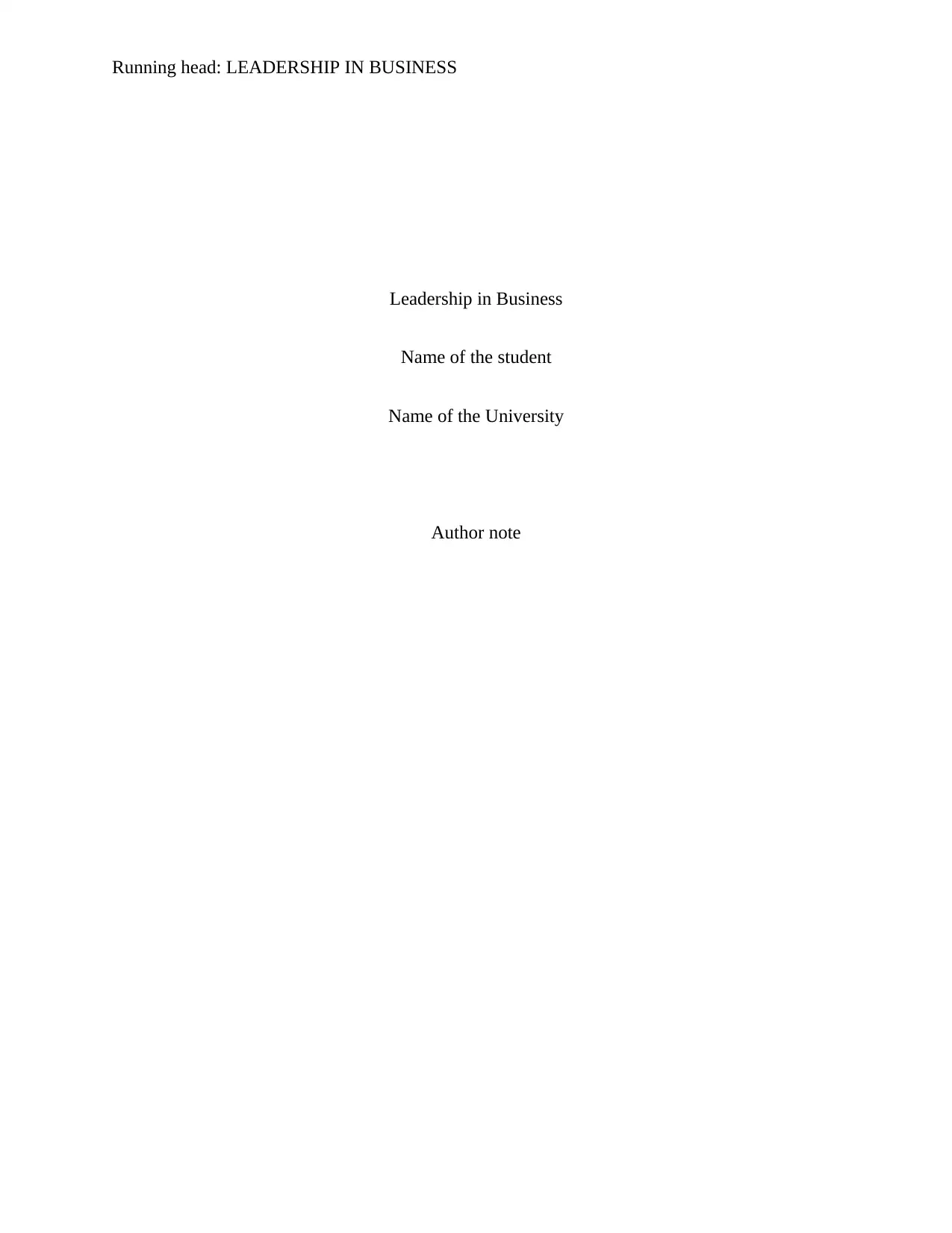
Running head: LEADERSHIP IN BUSINESS
Leadership in Business
Name of the student
Name of the University
Author note
Leadership in Business
Name of the student
Name of the University
Author note
Paraphrase This Document
Need a fresh take? Get an instant paraphrase of this document with our AI Paraphraser
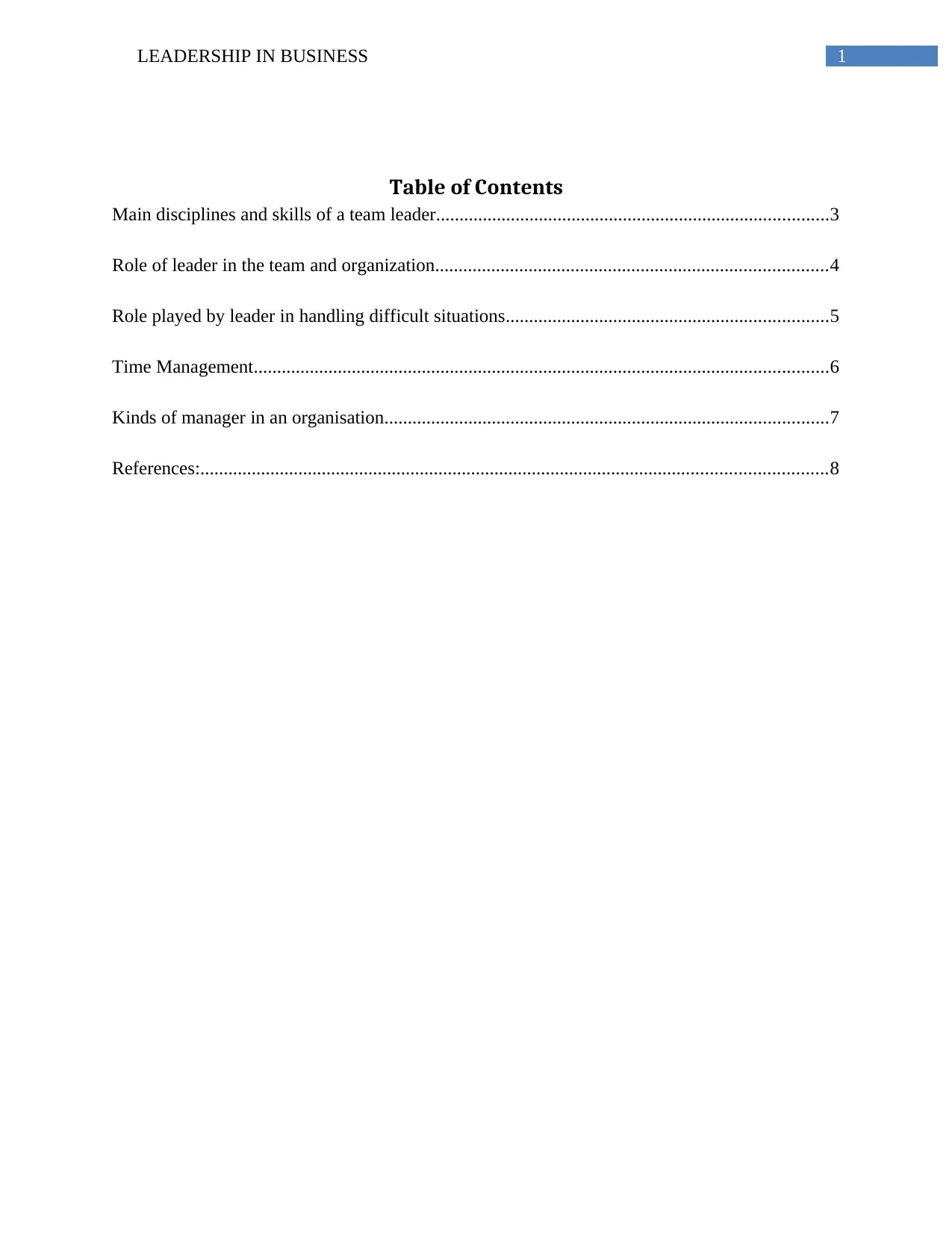
1LEADERSHIP IN BUSINESS
Table of Contents
Main disciplines and skills of a team leader....................................................................................3
Role of leader in the team and organization....................................................................................4
Role played by leader in handling difficult situations.....................................................................5
Time Management...........................................................................................................................6
Kinds of manager in an organisation...............................................................................................7
References:......................................................................................................................................8
Table of Contents
Main disciplines and skills of a team leader....................................................................................3
Role of leader in the team and organization....................................................................................4
Role played by leader in handling difficult situations.....................................................................5
Time Management...........................................................................................................................6
Kinds of manager in an organisation...............................................................................................7
References:......................................................................................................................................8
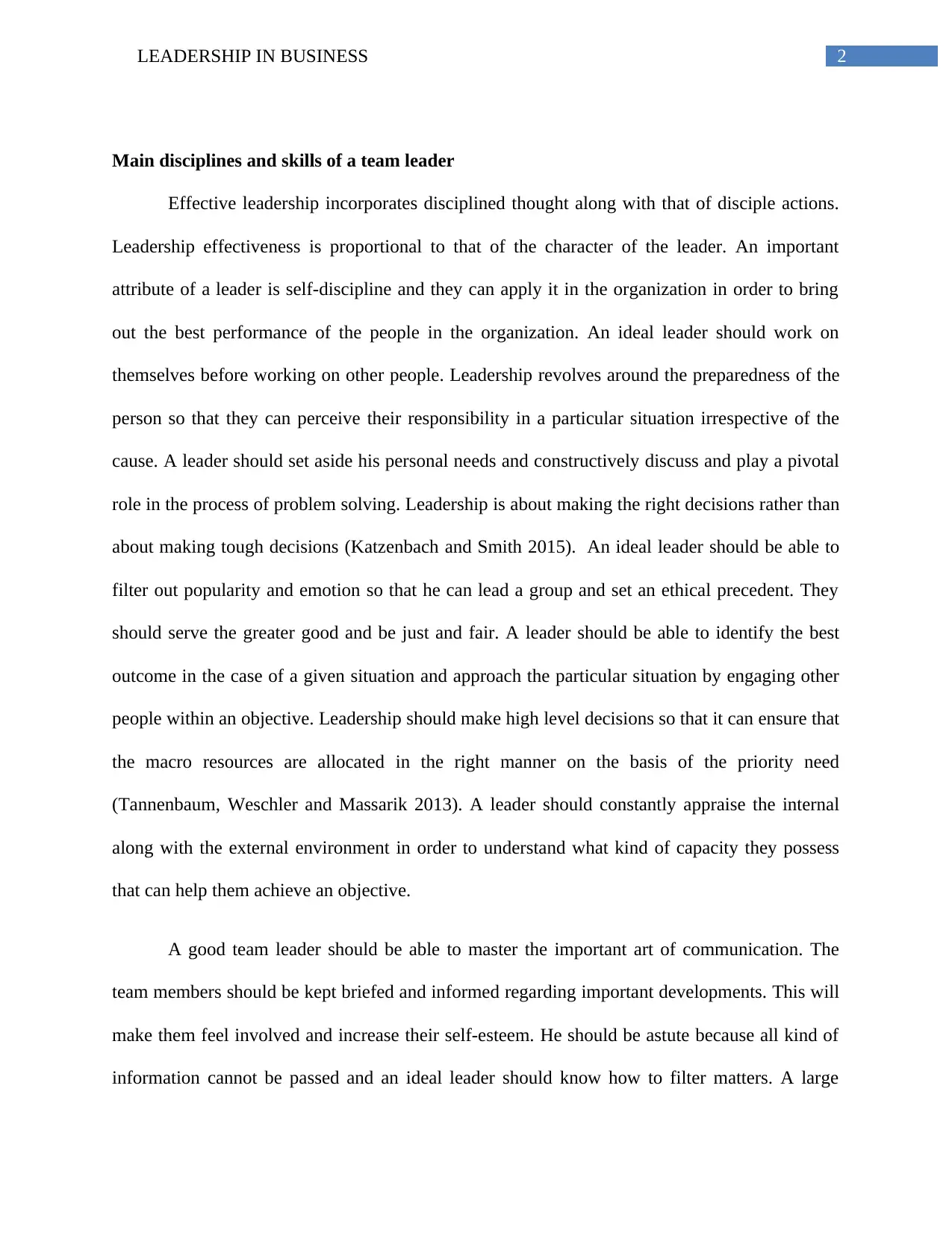
2LEADERSHIP IN BUSINESS
Main disciplines and skills of a team leader
Effective leadership incorporates disciplined thought along with that of disciple actions.
Leadership effectiveness is proportional to that of the character of the leader. An important
attribute of a leader is self-discipline and they can apply it in the organization in order to bring
out the best performance of the people in the organization. An ideal leader should work on
themselves before working on other people. Leadership revolves around the preparedness of the
person so that they can perceive their responsibility in a particular situation irrespective of the
cause. A leader should set aside his personal needs and constructively discuss and play a pivotal
role in the process of problem solving. Leadership is about making the right decisions rather than
about making tough decisions (Katzenbach and Smith 2015). An ideal leader should be able to
filter out popularity and emotion so that he can lead a group and set an ethical precedent. They
should serve the greater good and be just and fair. A leader should be able to identify the best
outcome in the case of a given situation and approach the particular situation by engaging other
people within an objective. Leadership should make high level decisions so that it can ensure that
the macro resources are allocated in the right manner on the basis of the priority need
(Tannenbaum, Weschler and Massarik 2013). A leader should constantly appraise the internal
along with the external environment in order to understand what kind of capacity they possess
that can help them achieve an objective.
A good team leader should be able to master the important art of communication. The
team members should be kept briefed and informed regarding important developments. This will
make them feel involved and increase their self-esteem. He should be astute because all kind of
information cannot be passed and an ideal leader should know how to filter matters. A large
Main disciplines and skills of a team leader
Effective leadership incorporates disciplined thought along with that of disciple actions.
Leadership effectiveness is proportional to that of the character of the leader. An important
attribute of a leader is self-discipline and they can apply it in the organization in order to bring
out the best performance of the people in the organization. An ideal leader should work on
themselves before working on other people. Leadership revolves around the preparedness of the
person so that they can perceive their responsibility in a particular situation irrespective of the
cause. A leader should set aside his personal needs and constructively discuss and play a pivotal
role in the process of problem solving. Leadership is about making the right decisions rather than
about making tough decisions (Katzenbach and Smith 2015). An ideal leader should be able to
filter out popularity and emotion so that he can lead a group and set an ethical precedent. They
should serve the greater good and be just and fair. A leader should be able to identify the best
outcome in the case of a given situation and approach the particular situation by engaging other
people within an objective. Leadership should make high level decisions so that it can ensure that
the macro resources are allocated in the right manner on the basis of the priority need
(Tannenbaum, Weschler and Massarik 2013). A leader should constantly appraise the internal
along with the external environment in order to understand what kind of capacity they possess
that can help them achieve an objective.
A good team leader should be able to master the important art of communication. The
team members should be kept briefed and informed regarding important developments. This will
make them feel involved and increase their self-esteem. He should be astute because all kind of
information cannot be passed and an ideal leader should know how to filter matters. A large
⊘ This is a preview!⊘
Do you want full access?
Subscribe today to unlock all pages.

Trusted by 1+ million students worldwide
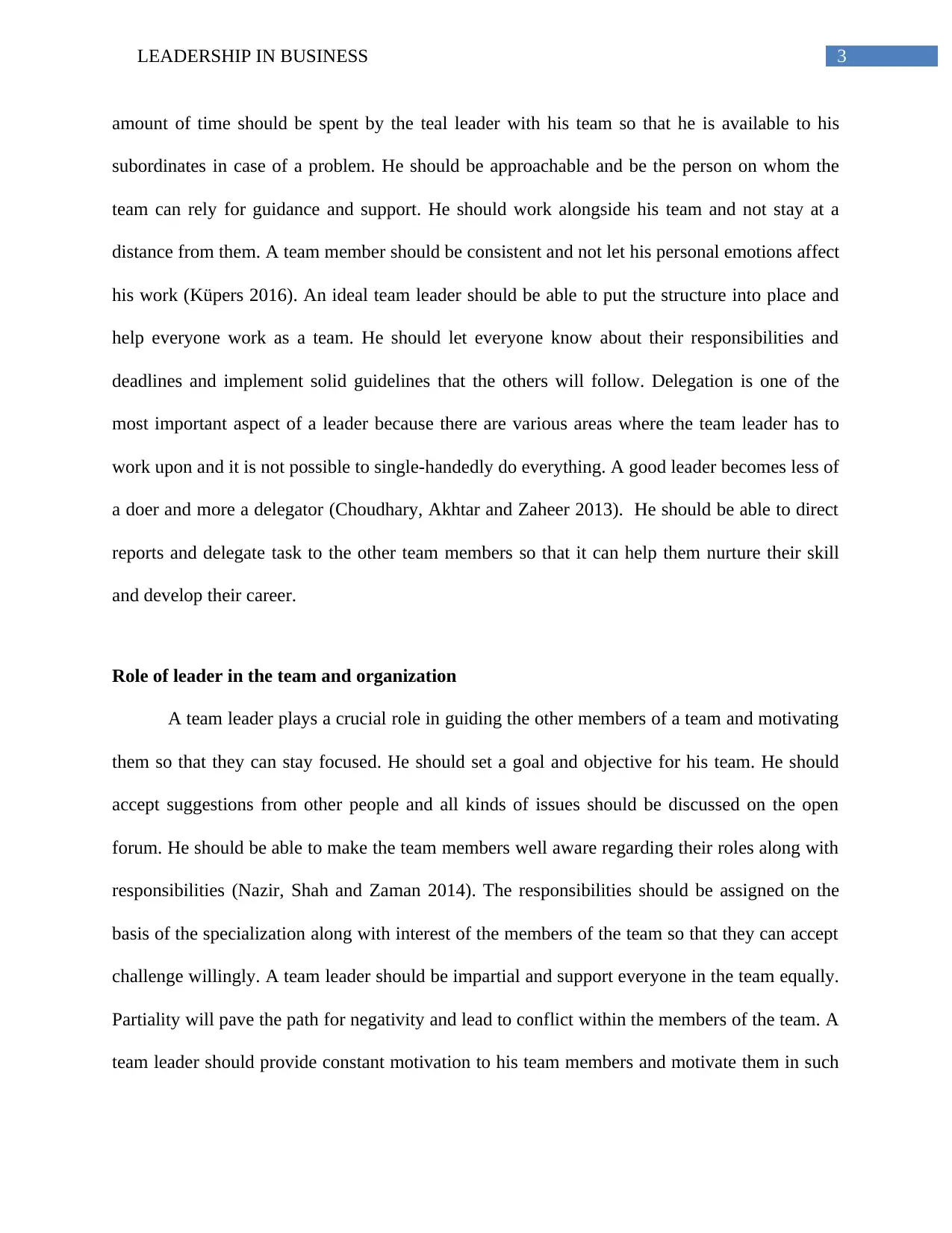
3LEADERSHIP IN BUSINESS
amount of time should be spent by the teal leader with his team so that he is available to his
subordinates in case of a problem. He should be approachable and be the person on whom the
team can rely for guidance and support. He should work alongside his team and not stay at a
distance from them. A team member should be consistent and not let his personal emotions affect
his work (Küpers 2016). An ideal team leader should be able to put the structure into place and
help everyone work as a team. He should let everyone know about their responsibilities and
deadlines and implement solid guidelines that the others will follow. Delegation is one of the
most important aspect of a leader because there are various areas where the team leader has to
work upon and it is not possible to single-handedly do everything. A good leader becomes less of
a doer and more a delegator (Choudhary, Akhtar and Zaheer 2013). He should be able to direct
reports and delegate task to the other team members so that it can help them nurture their skill
and develop their career.
Role of leader in the team and organization
A team leader plays a crucial role in guiding the other members of a team and motivating
them so that they can stay focused. He should set a goal and objective for his team. He should
accept suggestions from other people and all kinds of issues should be discussed on the open
forum. He should be able to make the team members well aware regarding their roles along with
responsibilities (Nazir, Shah and Zaman 2014). The responsibilities should be assigned on the
basis of the specialization along with interest of the members of the team so that they can accept
challenge willingly. A team leader should be impartial and support everyone in the team equally.
Partiality will pave the path for negativity and lead to conflict within the members of the team. A
team leader should provide constant motivation to his team members and motivate them in such
amount of time should be spent by the teal leader with his team so that he is available to his
subordinates in case of a problem. He should be approachable and be the person on whom the
team can rely for guidance and support. He should work alongside his team and not stay at a
distance from them. A team member should be consistent and not let his personal emotions affect
his work (Küpers 2016). An ideal team leader should be able to put the structure into place and
help everyone work as a team. He should let everyone know about their responsibilities and
deadlines and implement solid guidelines that the others will follow. Delegation is one of the
most important aspect of a leader because there are various areas where the team leader has to
work upon and it is not possible to single-handedly do everything. A good leader becomes less of
a doer and more a delegator (Choudhary, Akhtar and Zaheer 2013). He should be able to direct
reports and delegate task to the other team members so that it can help them nurture their skill
and develop their career.
Role of leader in the team and organization
A team leader plays a crucial role in guiding the other members of a team and motivating
them so that they can stay focused. He should set a goal and objective for his team. He should
accept suggestions from other people and all kinds of issues should be discussed on the open
forum. He should be able to make the team members well aware regarding their roles along with
responsibilities (Nazir, Shah and Zaman 2014). The responsibilities should be assigned on the
basis of the specialization along with interest of the members of the team so that they can accept
challenge willingly. A team leader should be impartial and support everyone in the team equally.
Partiality will pave the path for negativity and lead to conflict within the members of the team. A
team leader should provide constant motivation to his team members and motivate them in such
Paraphrase This Document
Need a fresh take? Get an instant paraphrase of this document with our AI Paraphraser
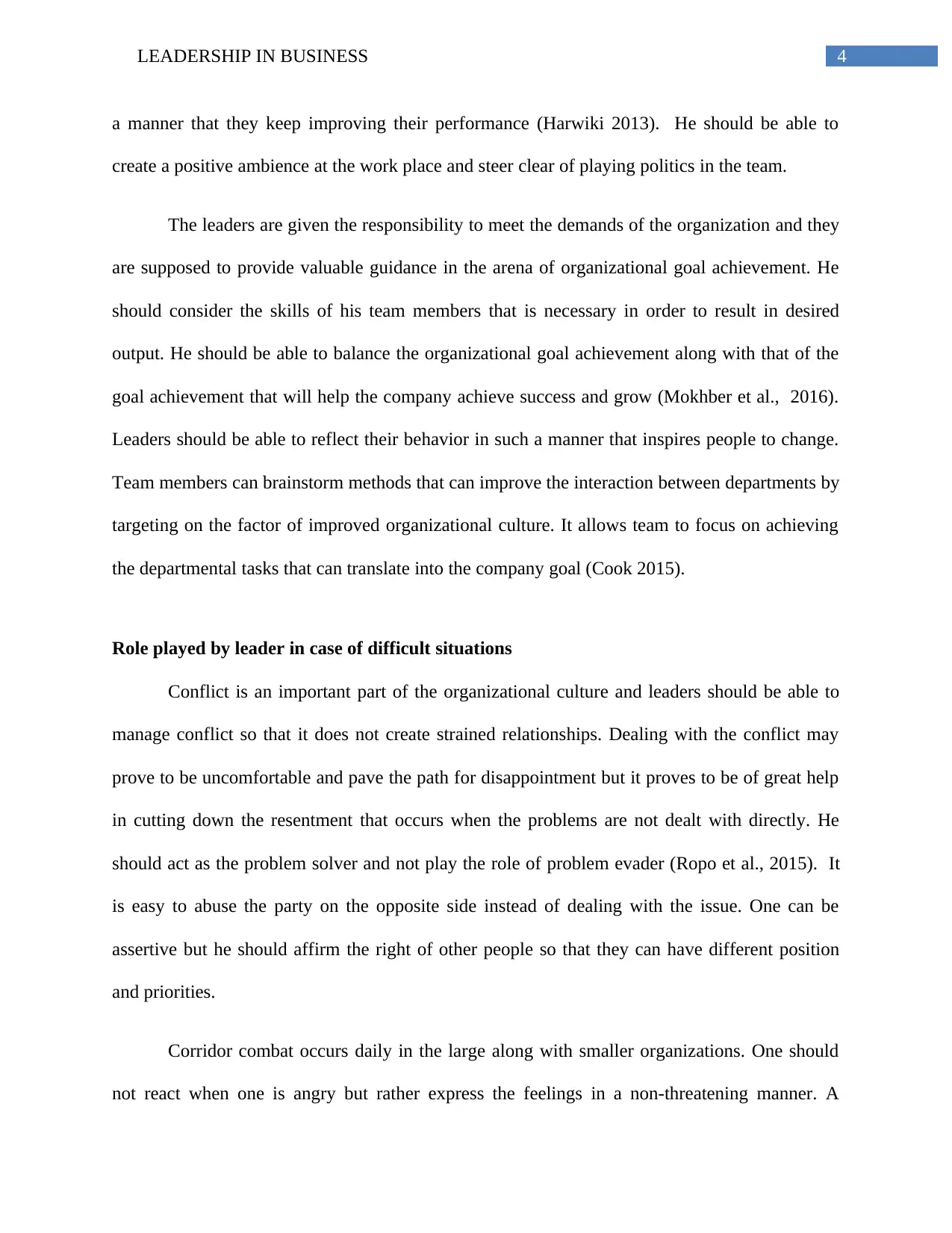
4LEADERSHIP IN BUSINESS
a manner that they keep improving their performance (Harwiki 2013). He should be able to
create a positive ambience at the work place and steer clear of playing politics in the team.
The leaders are given the responsibility to meet the demands of the organization and they
are supposed to provide valuable guidance in the arena of organizational goal achievement. He
should consider the skills of his team members that is necessary in order to result in desired
output. He should be able to balance the organizational goal achievement along with that of the
goal achievement that will help the company achieve success and grow (Mokhber et al., 2016).
Leaders should be able to reflect their behavior in such a manner that inspires people to change.
Team members can brainstorm methods that can improve the interaction between departments by
targeting on the factor of improved organizational culture. It allows team to focus on achieving
the departmental tasks that can translate into the company goal (Cook 2015).
Role played by leader in case of difficult situations
Conflict is an important part of the organizational culture and leaders should be able to
manage conflict so that it does not create strained relationships. Dealing with the conflict may
prove to be uncomfortable and pave the path for disappointment but it proves to be of great help
in cutting down the resentment that occurs when the problems are not dealt with directly. He
should act as the problem solver and not play the role of problem evader (Ropo et al., 2015). It
is easy to abuse the party on the opposite side instead of dealing with the issue. One can be
assertive but he should affirm the right of other people so that they can have different position
and priorities.
Corridor combat occurs daily in the large along with smaller organizations. One should
not react when one is angry but rather express the feelings in a non-threatening manner. A
a manner that they keep improving their performance (Harwiki 2013). He should be able to
create a positive ambience at the work place and steer clear of playing politics in the team.
The leaders are given the responsibility to meet the demands of the organization and they
are supposed to provide valuable guidance in the arena of organizational goal achievement. He
should consider the skills of his team members that is necessary in order to result in desired
output. He should be able to balance the organizational goal achievement along with that of the
goal achievement that will help the company achieve success and grow (Mokhber et al., 2016).
Leaders should be able to reflect their behavior in such a manner that inspires people to change.
Team members can brainstorm methods that can improve the interaction between departments by
targeting on the factor of improved organizational culture. It allows team to focus on achieving
the departmental tasks that can translate into the company goal (Cook 2015).
Role played by leader in case of difficult situations
Conflict is an important part of the organizational culture and leaders should be able to
manage conflict so that it does not create strained relationships. Dealing with the conflict may
prove to be uncomfortable and pave the path for disappointment but it proves to be of great help
in cutting down the resentment that occurs when the problems are not dealt with directly. He
should act as the problem solver and not play the role of problem evader (Ropo et al., 2015). It
is easy to abuse the party on the opposite side instead of dealing with the issue. One can be
assertive but he should affirm the right of other people so that they can have different position
and priorities.
Corridor combat occurs daily in the large along with smaller organizations. One should
not react when one is angry but rather express the feelings in a non-threatening manner. A
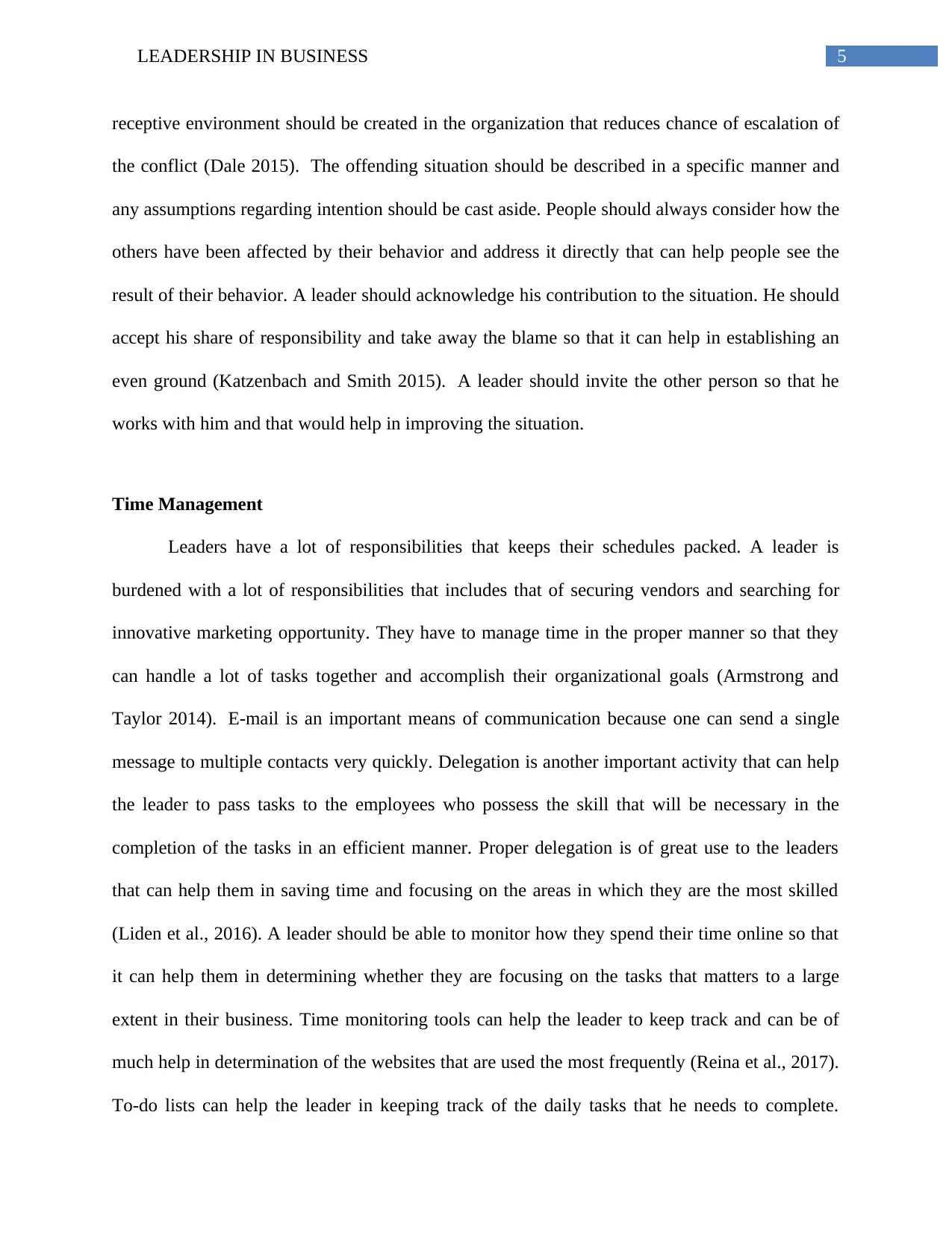
5LEADERSHIP IN BUSINESS
receptive environment should be created in the organization that reduces chance of escalation of
the conflict (Dale 2015). The offending situation should be described in a specific manner and
any assumptions regarding intention should be cast aside. People should always consider how the
others have been affected by their behavior and address it directly that can help people see the
result of their behavior. A leader should acknowledge his contribution to the situation. He should
accept his share of responsibility and take away the blame so that it can help in establishing an
even ground (Katzenbach and Smith 2015). A leader should invite the other person so that he
works with him and that would help in improving the situation.
Time Management
Leaders have a lot of responsibilities that keeps their schedules packed. A leader is
burdened with a lot of responsibilities that includes that of securing vendors and searching for
innovative marketing opportunity. They have to manage time in the proper manner so that they
can handle a lot of tasks together and accomplish their organizational goals (Armstrong and
Taylor 2014). E-mail is an important means of communication because one can send a single
message to multiple contacts very quickly. Delegation is another important activity that can help
the leader to pass tasks to the employees who possess the skill that will be necessary in the
completion of the tasks in an efficient manner. Proper delegation is of great use to the leaders
that can help them in saving time and focusing on the areas in which they are the most skilled
(Liden et al., 2016). A leader should be able to monitor how they spend their time online so that
it can help them in determining whether they are focusing on the tasks that matters to a large
extent in their business. Time monitoring tools can help the leader to keep track and can be of
much help in determination of the websites that are used the most frequently (Reina et al., 2017).
To-do lists can help the leader in keeping track of the daily tasks that he needs to complete.
receptive environment should be created in the organization that reduces chance of escalation of
the conflict (Dale 2015). The offending situation should be described in a specific manner and
any assumptions regarding intention should be cast aside. People should always consider how the
others have been affected by their behavior and address it directly that can help people see the
result of their behavior. A leader should acknowledge his contribution to the situation. He should
accept his share of responsibility and take away the blame so that it can help in establishing an
even ground (Katzenbach and Smith 2015). A leader should invite the other person so that he
works with him and that would help in improving the situation.
Time Management
Leaders have a lot of responsibilities that keeps their schedules packed. A leader is
burdened with a lot of responsibilities that includes that of securing vendors and searching for
innovative marketing opportunity. They have to manage time in the proper manner so that they
can handle a lot of tasks together and accomplish their organizational goals (Armstrong and
Taylor 2014). E-mail is an important means of communication because one can send a single
message to multiple contacts very quickly. Delegation is another important activity that can help
the leader to pass tasks to the employees who possess the skill that will be necessary in the
completion of the tasks in an efficient manner. Proper delegation is of great use to the leaders
that can help them in saving time and focusing on the areas in which they are the most skilled
(Liden et al., 2016). A leader should be able to monitor how they spend their time online so that
it can help them in determining whether they are focusing on the tasks that matters to a large
extent in their business. Time monitoring tools can help the leader to keep track and can be of
much help in determination of the websites that are used the most frequently (Reina et al., 2017).
To-do lists can help the leader in keeping track of the daily tasks that he needs to complete.
⊘ This is a preview!⊘
Do you want full access?
Subscribe today to unlock all pages.

Trusted by 1+ million students worldwide
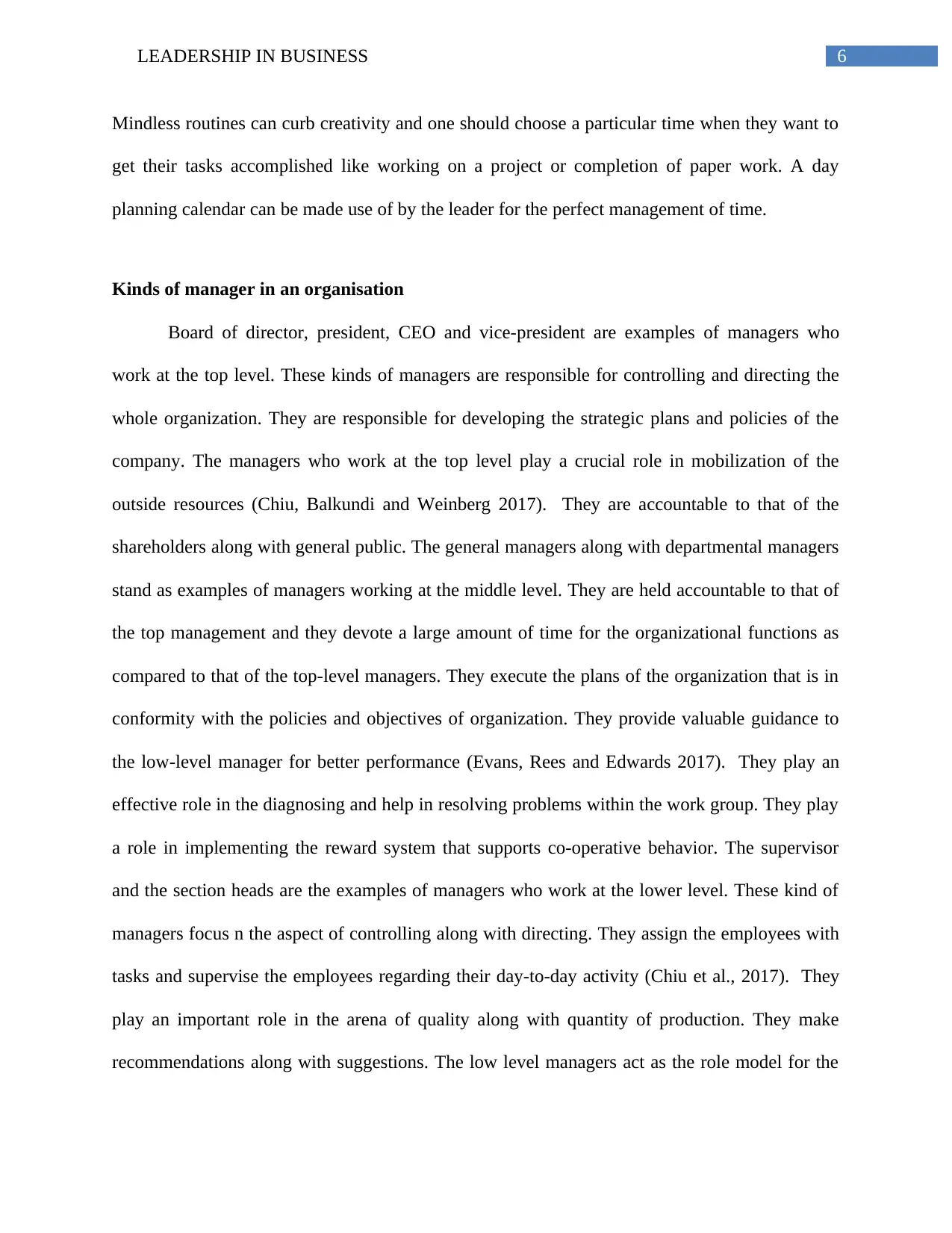
6LEADERSHIP IN BUSINESS
Mindless routines can curb creativity and one should choose a particular time when they want to
get their tasks accomplished like working on a project or completion of paper work. A day
planning calendar can be made use of by the leader for the perfect management of time.
Kinds of manager in an organisation
Board of director, president, CEO and vice-president are examples of managers who
work at the top level. These kinds of managers are responsible for controlling and directing the
whole organization. They are responsible for developing the strategic plans and policies of the
company. The managers who work at the top level play a crucial role in mobilization of the
outside resources (Chiu, Balkundi and Weinberg 2017). They are accountable to that of the
shareholders along with general public. The general managers along with departmental managers
stand as examples of managers working at the middle level. They are held accountable to that of
the top management and they devote a large amount of time for the organizational functions as
compared to that of the top-level managers. They execute the plans of the organization that is in
conformity with the policies and objectives of organization. They provide valuable guidance to
the low-level manager for better performance (Evans, Rees and Edwards 2017). They play an
effective role in the diagnosing and help in resolving problems within the work group. They play
a role in implementing the reward system that supports co-operative behavior. The supervisor
and the section heads are the examples of managers who work at the lower level. These kind of
managers focus n the aspect of controlling along with directing. They assign the employees with
tasks and supervise the employees regarding their day-to-day activity (Chiu et al., 2017). They
play an important role in the arena of quality along with quantity of production. They make
recommendations along with suggestions. The low level managers act as the role model for the
Mindless routines can curb creativity and one should choose a particular time when they want to
get their tasks accomplished like working on a project or completion of paper work. A day
planning calendar can be made use of by the leader for the perfect management of time.
Kinds of manager in an organisation
Board of director, president, CEO and vice-president are examples of managers who
work at the top level. These kinds of managers are responsible for controlling and directing the
whole organization. They are responsible for developing the strategic plans and policies of the
company. The managers who work at the top level play a crucial role in mobilization of the
outside resources (Chiu, Balkundi and Weinberg 2017). They are accountable to that of the
shareholders along with general public. The general managers along with departmental managers
stand as examples of managers working at the middle level. They are held accountable to that of
the top management and they devote a large amount of time for the organizational functions as
compared to that of the top-level managers. They execute the plans of the organization that is in
conformity with the policies and objectives of organization. They provide valuable guidance to
the low-level manager for better performance (Evans, Rees and Edwards 2017). They play an
effective role in the diagnosing and help in resolving problems within the work group. They play
a role in implementing the reward system that supports co-operative behavior. The supervisor
and the section heads are the examples of managers who work at the lower level. These kind of
managers focus n the aspect of controlling along with directing. They assign the employees with
tasks and supervise the employees regarding their day-to-day activity (Chiu et al., 2017). They
play an important role in the arena of quality along with quantity of production. They make
recommendations along with suggestions. The low level managers act as the role model for the
Paraphrase This Document
Need a fresh take? Get an instant paraphrase of this document with our AI Paraphraser
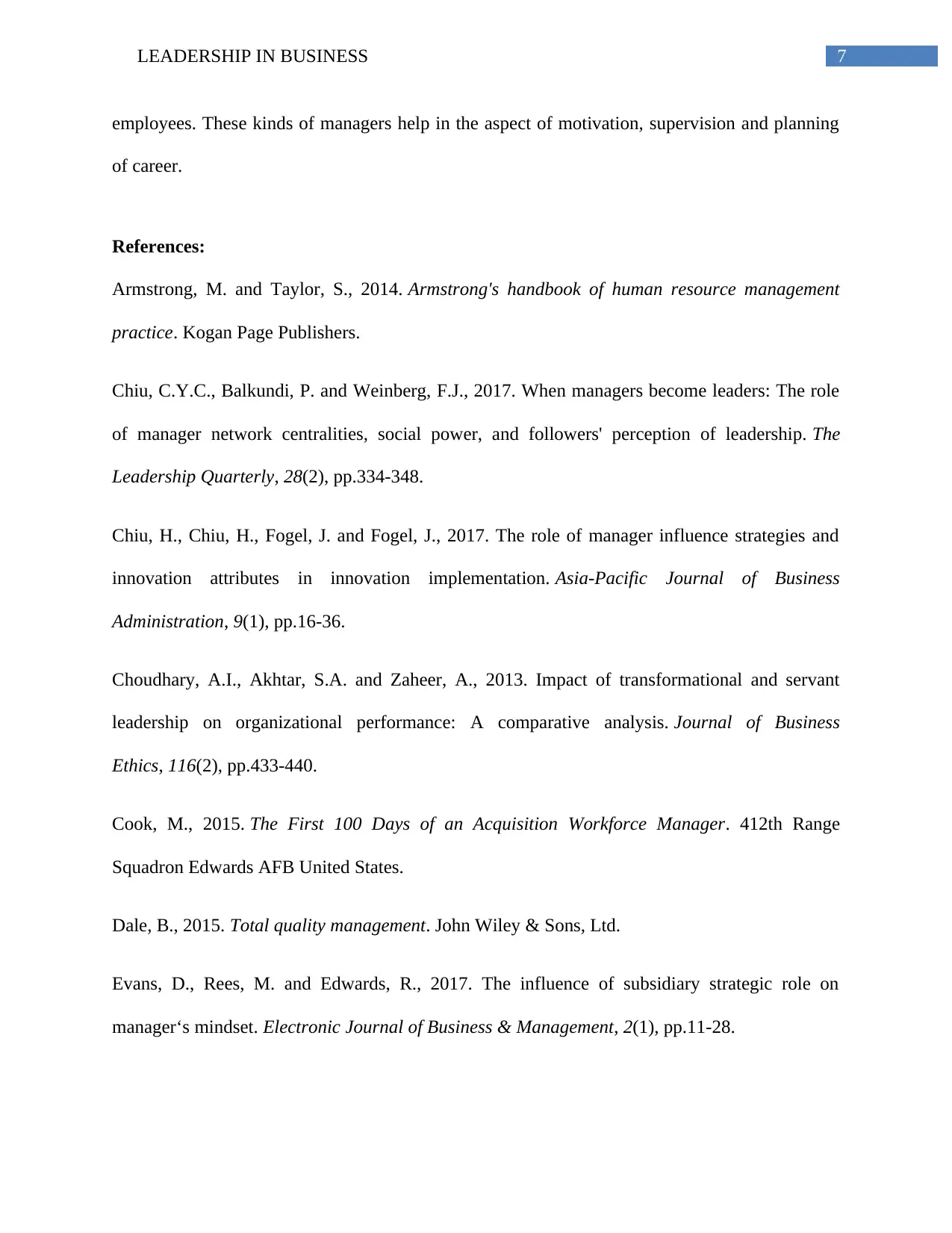
7LEADERSHIP IN BUSINESS
employees. These kinds of managers help in the aspect of motivation, supervision and planning
of career.
References:
Armstrong, M. and Taylor, S., 2014. Armstrong's handbook of human resource management
practice. Kogan Page Publishers.
Chiu, C.Y.C., Balkundi, P. and Weinberg, F.J., 2017. When managers become leaders: The role
of manager network centralities, social power, and followers' perception of leadership. The
Leadership Quarterly, 28(2), pp.334-348.
Chiu, H., Chiu, H., Fogel, J. and Fogel, J., 2017. The role of manager influence strategies and
innovation attributes in innovation implementation. Asia-Pacific Journal of Business
Administration, 9(1), pp.16-36.
Choudhary, A.I., Akhtar, S.A. and Zaheer, A., 2013. Impact of transformational and servant
leadership on organizational performance: A comparative analysis. Journal of Business
Ethics, 116(2), pp.433-440.
Cook, M., 2015. The First 100 Days of an Acquisition Workforce Manager. 412th Range
Squadron Edwards AFB United States.
Dale, B., 2015. Total quality management. John Wiley & Sons, Ltd.
Evans, D., Rees, M. and Edwards, R., 2017. The influence of subsidiary strategic role on
manager‘s mindset. Electronic Journal of Business & Management, 2(1), pp.11-28.
employees. These kinds of managers help in the aspect of motivation, supervision and planning
of career.
References:
Armstrong, M. and Taylor, S., 2014. Armstrong's handbook of human resource management
practice. Kogan Page Publishers.
Chiu, C.Y.C., Balkundi, P. and Weinberg, F.J., 2017. When managers become leaders: The role
of manager network centralities, social power, and followers' perception of leadership. The
Leadership Quarterly, 28(2), pp.334-348.
Chiu, H., Chiu, H., Fogel, J. and Fogel, J., 2017. The role of manager influence strategies and
innovation attributes in innovation implementation. Asia-Pacific Journal of Business
Administration, 9(1), pp.16-36.
Choudhary, A.I., Akhtar, S.A. and Zaheer, A., 2013. Impact of transformational and servant
leadership on organizational performance: A comparative analysis. Journal of Business
Ethics, 116(2), pp.433-440.
Cook, M., 2015. The First 100 Days of an Acquisition Workforce Manager. 412th Range
Squadron Edwards AFB United States.
Dale, B., 2015. Total quality management. John Wiley & Sons, Ltd.
Evans, D., Rees, M. and Edwards, R., 2017. The influence of subsidiary strategic role on
manager‘s mindset. Electronic Journal of Business & Management, 2(1), pp.11-28.
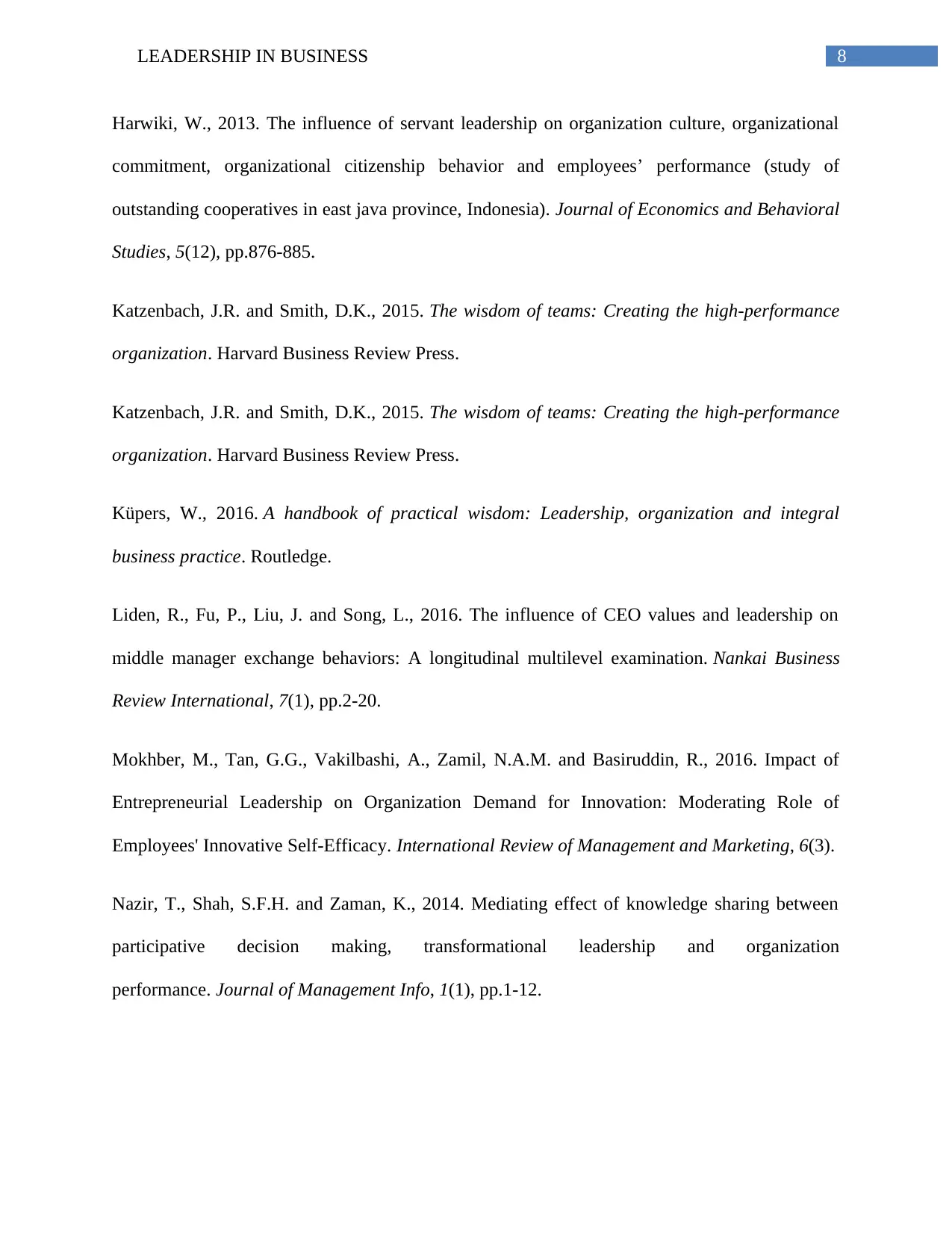
8LEADERSHIP IN BUSINESS
Harwiki, W., 2013. The influence of servant leadership on organization culture, organizational
commitment, organizational citizenship behavior and employees’ performance (study of
outstanding cooperatives in east java province, Indonesia). Journal of Economics and Behavioral
Studies, 5(12), pp.876-885.
Katzenbach, J.R. and Smith, D.K., 2015. The wisdom of teams: Creating the high-performance
organization. Harvard Business Review Press.
Katzenbach, J.R. and Smith, D.K., 2015. The wisdom of teams: Creating the high-performance
organization. Harvard Business Review Press.
Küpers, W., 2016. A handbook of practical wisdom: Leadership, organization and integral
business practice. Routledge.
Liden, R., Fu, P., Liu, J. and Song, L., 2016. The influence of CEO values and leadership on
middle manager exchange behaviors: A longitudinal multilevel examination. Nankai Business
Review International, 7(1), pp.2-20.
Mokhber, M., Tan, G.G., Vakilbashi, A., Zamil, N.A.M. and Basiruddin, R., 2016. Impact of
Entrepreneurial Leadership on Organization Demand for Innovation: Moderating Role of
Employees' Innovative Self-Efficacy. International Review of Management and Marketing, 6(3).
Nazir, T., Shah, S.F.H. and Zaman, K., 2014. Mediating effect of knowledge sharing between
participative decision making, transformational leadership and organization
performance. Journal of Management Info, 1(1), pp.1-12.
Harwiki, W., 2013. The influence of servant leadership on organization culture, organizational
commitment, organizational citizenship behavior and employees’ performance (study of
outstanding cooperatives in east java province, Indonesia). Journal of Economics and Behavioral
Studies, 5(12), pp.876-885.
Katzenbach, J.R. and Smith, D.K., 2015. The wisdom of teams: Creating the high-performance
organization. Harvard Business Review Press.
Katzenbach, J.R. and Smith, D.K., 2015. The wisdom of teams: Creating the high-performance
organization. Harvard Business Review Press.
Küpers, W., 2016. A handbook of practical wisdom: Leadership, organization and integral
business practice. Routledge.
Liden, R., Fu, P., Liu, J. and Song, L., 2016. The influence of CEO values and leadership on
middle manager exchange behaviors: A longitudinal multilevel examination. Nankai Business
Review International, 7(1), pp.2-20.
Mokhber, M., Tan, G.G., Vakilbashi, A., Zamil, N.A.M. and Basiruddin, R., 2016. Impact of
Entrepreneurial Leadership on Organization Demand for Innovation: Moderating Role of
Employees' Innovative Self-Efficacy. International Review of Management and Marketing, 6(3).
Nazir, T., Shah, S.F.H. and Zaman, K., 2014. Mediating effect of knowledge sharing between
participative decision making, transformational leadership and organization
performance. Journal of Management Info, 1(1), pp.1-12.
⊘ This is a preview!⊘
Do you want full access?
Subscribe today to unlock all pages.

Trusted by 1+ million students worldwide
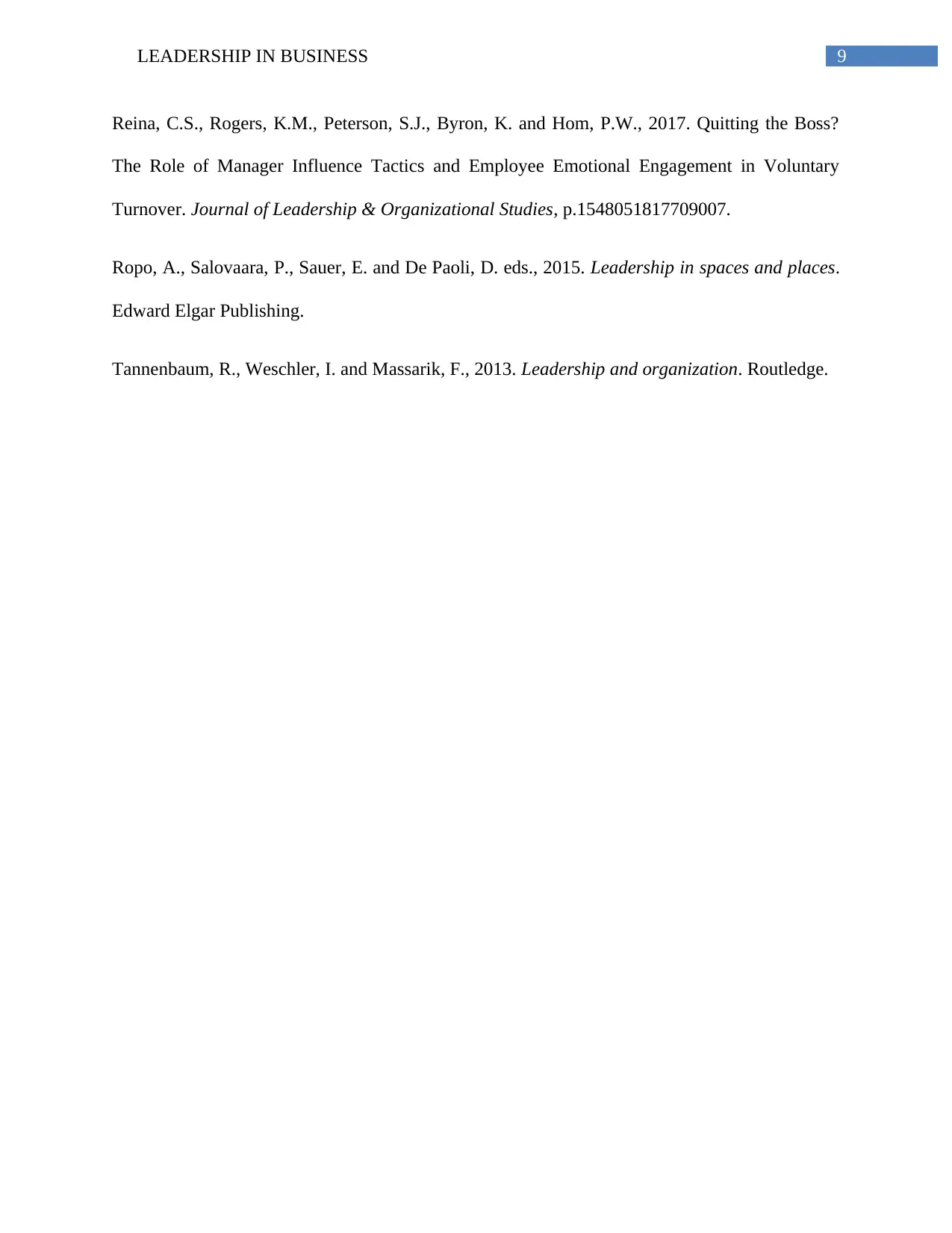
9LEADERSHIP IN BUSINESS
Reina, C.S., Rogers, K.M., Peterson, S.J., Byron, K. and Hom, P.W., 2017. Quitting the Boss?
The Role of Manager Influence Tactics and Employee Emotional Engagement in Voluntary
Turnover. Journal of Leadership & Organizational Studies, p.1548051817709007.
Ropo, A., Salovaara, P., Sauer, E. and De Paoli, D. eds., 2015. Leadership in spaces and places.
Edward Elgar Publishing.
Tannenbaum, R., Weschler, I. and Massarik, F., 2013. Leadership and organization. Routledge.
Reina, C.S., Rogers, K.M., Peterson, S.J., Byron, K. and Hom, P.W., 2017. Quitting the Boss?
The Role of Manager Influence Tactics and Employee Emotional Engagement in Voluntary
Turnover. Journal of Leadership & Organizational Studies, p.1548051817709007.
Ropo, A., Salovaara, P., Sauer, E. and De Paoli, D. eds., 2015. Leadership in spaces and places.
Edward Elgar Publishing.
Tannenbaum, R., Weschler, I. and Massarik, F., 2013. Leadership and organization. Routledge.
1 out of 10
Related Documents
Your All-in-One AI-Powered Toolkit for Academic Success.
+13062052269
info@desklib.com
Available 24*7 on WhatsApp / Email
![[object Object]](/_next/static/media/star-bottom.7253800d.svg)
Unlock your academic potential
Copyright © 2020–2025 A2Z Services. All Rights Reserved. Developed and managed by ZUCOL.





